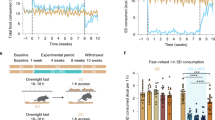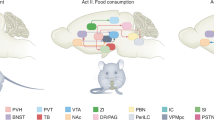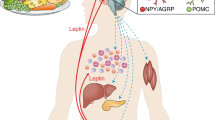Abstract
Powerful biological mechanisms evolved to defend adequate nutrient supply and optimal levels of body weight/adiposity. Low levels of leptin indicating food deprivation and depleted fat stores have been identified as the strongest signals to induce adaptive biological actions such as increased energy intake and reduced energy expenditure. In concert with other signals from the gut and metabolically active tissues, low leptin levels trigger powerful activation of multiple peripheral and brain systems to restore energy balance. It is not just neurons in the arcuate nucleus, but many other brain systems involved in finding potential food sources, smelling and tasting food, and learning to maximize rewarding effects of foods, that are affected by low leptin. Food restriction and fat depletion thus lead to a ‘hungry’ brain, preoccupied with food. By contrast, because of less (adaptive thrifty fuel efficiency) or lost (lack of predators) evolutionary pressure, the upper limits of body weight/adiposity are not as strongly defended by high levels of leptin and other signals. The modern environment is characterized by the increased availability of large amounts of energy-dense foods and increased presence of powerful food cues, together with minimal physical procurement costs and a sedentary lifestyle. Much of these environmental influences affect cortico-limbic brain areas concerned with learning and memory, reward, mood and emotion. Common obesity results when individual predisposition to deal with a restrictive environment, as engraved by genetics, epigenetics and/or early life experience, is confronted with an environment of plenty. Therefore, increased adiposity in prone individuals should be seen as a normal physiological response to a changed environment, not in the pathology of the regulatory system. The first line of defense should ideally lie in modifications to the environment and lifestyle. However, as such modifications will be slow and incomplete, it is equally important to gain better insight into how the brain deals with environmental stimuli and to develop behavioral strategies to better cope with them. Clearly, alternative therapeutic strategies such as drugs and bariatric surgery should also be considered to prevent or treat this debilitating disease. It will be crucial to understand the functional crosstalk between neural systems responding to metabolic and environmental stimuli, i.e. crosstalk between hypothalamic and cortico-limbic circuitry.
This is a preview of subscription content, access via your institution
Access options
Subscribe to this journal
Receive 12 print issues and online access
$259.00 per year
only $21.58 per issue
Buy this article
- Purchase on Springer Link
- Instant access to full article PDF
Prices may be subject to local taxes which are calculated during checkout

Similar content being viewed by others
References
Berthoud H-R . Multiple neural systems controlling food intake and body weight. Neurosci Biobehav Rev 2002; 26: 393–428.
Berthoud HR, Morrison C . The brain, appetite, and obesity. Annu Rev Psychol 2008; 59: 55–92.
Schwartz MW . Brain pathways controlling food intake and body weight. Exp Biol Med (Maywood) 2001; 226: 978–981.
Minokoshi Y, Alquier T, Furukawa N, Kim YB, Lee A, Xue B et al. AMP-kinase regulates food intake by responding to hormonal and nutrient signals in the hypothalamus. Nature 2004; 428: 569–574.
Xue B, Kahn BB . AMPK integrates nutrient and hormonal signals to regulate food intake and energy balance through effects in the hypothalamus and peripheral tissues. J Physiol 2006; 574: 73–83.
von Frisch K . Dance language and Orientation of Bees. Harvard University Press: Cambridge, MA, 1967.
Riley JR, Greggers U, Smith AD, Reynolds DR, Menzel R . The flight paths of honeybees recruited by the waggle dance. Nature 2005; 435: 205–207.
Franks NR, Richardson T . Teaching in tandem-running ants. Nature 2006; 439: 153.
Verhagen JV . The neurocognitive bases of human multimodal food perception: Consciousness. Brain Res Brain Res Rev 2007; 53: 271–286.
de Araujo IE, Rolls ET, Velazco MI, Margot C, Cayeux I . Cognitive modulation of olfactory processing. Neuron 2005; 46: 671–679.
Shigemura N, Ohta R, Kusakabe Y, Miura H, Hino A, Koyano K et al. Leptin modulates behavioral responses to sweet substances by influencing peripheral taste structures. Endocrinology 2004; 145: 839–847.
Julliard AK, Chaput MA, Apelbaum A, Aime P, Mahfouz M, Duchamp-Viret P . Changes in rat olfactory detection performance induced by orexin and leptin mimicking fasting and satiation. Behav Brain Res 2007; 183: 123–129.
Uher R, Treasure J, Heining M, Brammer MJ, Campbell IC . Cerebral processing of food-related stimuli: effects of fasting and gender. Behav Brain Res 2006; 169: 111–119.
Getchell TV, Kwong K, Saunders CP, Stromberg AJ, Getchell ML . Leptin regulates olfactory-mediated behavior in ob/ob mice. Physiol Behav 2006; 87: 848–856.
Figlewicz DP . Adiposity signals and food reward: expanding the CNS roles of insulin and leptin. Am J Physiol Regul Integr Comp Physiol 2003; 284: R882–R892.
Hommel JD, Trinko R, Sears RM, Georgescu D, Liu ZW, Gao XB et al. Leptin receptor signaling in midbrain dopamine neurons regulates feeding. Neuron 2006; 51: 801–810.
Fulton S, Pissios P, Manchon RP, Stiles L, Frank L, Pothos EN et al. Leptin regulation of the mesoaccumbens dopamine pathway. Neuron 2006; 51: 811–822.
Farooqi IS, Bullmore E, Keogh J, Gillard J, O’Rahilly S, Fletcher PC . Leptin regulates striatal regions and human eating behavior. Science 2007; 317: 1355.
Chelikani PK, Haver AC, Reeve Jr JR, Keire DA, Reidelberger RD . Daily, intermittent intravenous infusion of peptide YY(3-36) reduces daily food intake and adiposity in rats. Am J Physiol Regul Integr Comp Physiol 2006; 290: R298–R305.
Batterham RL, ffytche DH, Rosenthal JM, Zelaya FO, Barker GJ, Withers DJ et al. PYY modulation of cortical and hypothalamic brain areas predicts feeding behaviour in humans. Nature 2007; 450: 106–109.
Diano S, Farr SA, Benoit SC, McNay EC, da Silva I, Horvath B et al. Ghrelin controls hippocampal spine synapse density and memory performance. Nat Neurosci 2006; 9: 381–388.
Schmid DA, Held K, Ising M, Uhr M, Weikel JC, Steiger A . Ghrelin stimulates appetite, imagination of food, GH, ACTH, and cortisol, but does not affect leptin in normal controls. Neuropsychopharmacology 2005; 30: 1187–1192.
Abizaid A, Liu ZW, Andrews ZB, Shanabrough M, Borok E, Elsworth JD et al. Ghrelin modulates the activity and synaptic input organization of midbrain dopamine neurons while promoting appetite. J Clin Invest 2006; 116: 3229–3239.
Jerlhag E, Egecioglu E, Dickson SL, Douhan A, Svensson L, Engel JA . Ghrelin administration into tegmental areas stimulates locomotor activity and increases extracellular concentration of dopamine in the nucleus accumbens. Addict Biol 2007; 12: 6–16.
Malik S, McGlone F, Bedrossian D, Dagher A . Ghrelin modulates brain activity in areas that control appetitive behavior. Cell Metab 2008; 7: 400–409.
Rosenbaum M, Sy M, Pavlovich K, Leibel RL, Hirsch J . Leptin reverses weight loss-induced changes in regional neural activity responses to visual food stimuli. J Clin Invest 2008; 118: 2583–2591.
Rosenbaum M, Murphy EM, Heymsfield SB, Matthews DE, Leibel RL . Low dose leptin administration reverses effects of sustained weight-reduction on energy expenditure and circulating concentrations of thyroid hormones. J Clin Endocrinol Metab 2002; 87: 2391–2394.
Berthoud HR . Mind versus metabolism in the control of food intake and energy balance. Physiol Behav 2004; 81: 781–793.
Corwin RL, Hajnal A . Too much of a good thing: neurobiology of non-homeostatic eating and drug abuse. Physiol Behav 2005; 86: 5–8.
Cameron J, Doucet E . Getting to the bottom of feeding behaviour: who′s on top? Appl Physiol Nutr Metab 2007; 32: 177–189.
Leibowitz SF . Overconsumption of dietary fat and alcohol: mechanisms involving lipids and hypothalamic peptides. Physiol Behav 2007; 91: 513–521.
Speakman JR . Thrifty genes for obesity and the metabolic syndrome—time to call off the search? Diab Vasc Dis Res 2006; 3: 7–11.
Heymsfield SB, Greenberg AS, Fujioka K, Dixon RM, Kushner R, Hunt T et al. Recombinant leptin for weight loss in obese and lean adults: a randomized, controlled, dose-escalation trial. JAMA 1999; 282: 1568–1575.
Hukshorn CJ, Saris WH, Westerterp-Plantenga MS, Farid AR, Smith FJ, Campfield LA . Weekly subcutaneous pegylated recombinant native human leptin (PEG-OB) administration in obese men. J Clin Endocrinol Metab 2000; 85: 4003–4009.
Banks WA, Farr SA, Morley JE . The effects of high fat diets on the blood-brain barrier transport of leptin: failure or adaptation? Physiol Behav 2006; 88: 244–248.
Wilsey J, Scarpace PJ . Caloric restriction reverses the deficits in leptin receptor protein and leptin signaling capacity associated with diet-induced obesity: role of leptin in the regulation of hypothalamic long-form leptin receptor expression. J Endocrinol 2004; 181: 297–306.
Rousseau K, Atcha Z, Loudon AS . Leptin and seasonal mammals. J Neuroendocrinol 2003; 15: 409–414.
Fogteloo AJ, Pijl H, Frolich M, McCamish M, Meinders AE . Effects of recombinant human leptin treatment as an adjunct of moderate energy restriction on body weight, resting energy expenditure and energy intake in obese humans. Diabetes Nutr Metab 2003; 16: 109–114.
Hill JO, Peters JC, Catenacci VA, Wyatt HR . International strategies to address obesity. Obes Rev 2008; 9 (Suppl 1): 41–47.
Harris J, Pomeranz J, Lobstein T, Brownell KD . A crisis in the marketplace: how food marketing contributes to childhood obesity and what can be done. Annu Rev Public Health 2009; 30: 211–225.
Wansink B, van Ittersum K, Painter JE . Ice cream illusions bowls, spoons, and self-served portion sizes. Am J Prev Med 2006; 31: 240–243.
Raynor HA, Wing RR . Effect of limiting snack food variety across days on hedonics and consumption. Appetite 2006; 46: 168–176.
Drewnowski A, Rehm CD, Solet D . Disparities in obesity rates: analysis by ZIP code area. Soc Sci Med 2007; 65: 2458–2463.
Rolls BJ, Roe LS, Meengs JS . The effect of large portion sizes on energy intake is sustained for 11 days. Obesity (Silver Spring) 2007; 15: 1535–1543.
McClure SM, Li J, Tomlin D, Cypert KS, Montague LM, Montague PR . Neural correlates of behavioral preference for culturally familiar drinks. Neuron 2004; 44: 379–387.
Kelly B, Smith B, King L, Flood V, Bauman A . Television food advertising to children: the extent and nature of exposure. Public Health Nutr 2007; 10: 1234–1240.
Thomson M, Spence JC, Raine K, Laing L . The association of television viewing with snacking behavior and body weight of young adults. Am J Health Promot 2008; 22: 329–335.
Badgaiyan RD . Cortical activation elicited by unrecognized stimuli. Behav Brain Funct 2006; 2: 17.
Aarts H, Custers R, Marien H . Preparing and motivating behavior outside of awareness. Science 2008; 319: 1639.
Acknowledgements
This work was supported by National Institute of Health DK071082.
Author information
Authors and Affiliations
Corresponding author
Rights and permissions
About this article
Cite this article
Zheng, H., Lenard, N., Shin, A. et al. Appetite control and energy balance regulation in the modern world: reward-driven brain overrides repletion signals. Int J Obes 33 (Suppl 2), S8–S13 (2009). https://doi.org/10.1038/ijo.2009.65
Published:
Issue Date:
DOI: https://doi.org/10.1038/ijo.2009.65
Keywords
This article is cited by
-
Understanding and co-managing medication treatment options for opioid use disorder
Internal and Emergency Medicine (2022)
-
Effect of transcranial direct current stimulation associated with hypocaloric diet on weight loss and metabolic profile in overweight or obesity: study protocol for a double-blind, randomized controlled clinical trial
Trials (2018)
-
Current pharmacotherapy for obesity
Nature Reviews Endocrinology (2018)
-
Ernährung und psychische Erkrankungen
Der Nervenarzt (2017)
-
The central nervous norepinephrine network links a diminished sense of emotional well-being to an increased body weight
International Journal of Obesity (2016)



